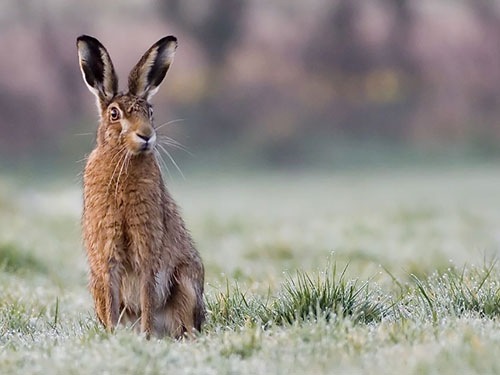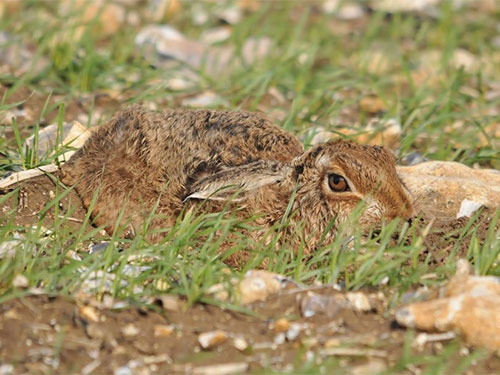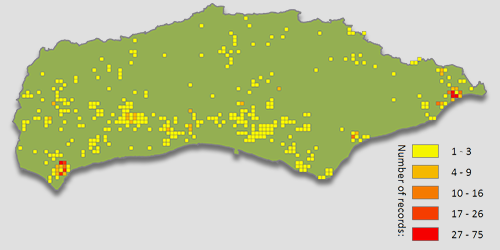


Amber eyes and ears with black tips: Hare
Photo: © Damian Waters/Sussex Wildlife Trust

The sit tight philosophy.
Photo: © Bob Eade/Sussex Wildlife Trust

Map showing where Brown Hares have been seen in Sussex but also large areas without any records
When we muse upon all things March, the mad hare has got to be up there. The Brown Hare is the most widespread of the two UK species, and the only one you’ll spot in Sussex. They are creatures of open country. Vegetarian grazers, occasionally indulging in a spot of browsing saplings. With a home range of some 50 hectares, their movement patterns track availability of fresh plant growth. Hares thrive in areas that provide grassland alongside arable land that incorporates cereals, leys, margins and winter stubbles; meeting their appetite for seasonal food.
Hares are naturalised mammals, and who introduced them is still disputed. Usually the Romans are implicated, although there are those that maintain their introduction pre-dates this, and they instead arrived some time during the Iron Age. Whenever they got here, I always get a thrill seeing a hare blazing its zigzag trail across the South Downs, nothing but chalk dust in its wake. If you’re still clarifying the difference between rabbits and hares in your mind. Did the ears have black tips? Hare. Did those amber eyes fix you with a slightly unnerving stare? Hare. Was there big air as it bounded away, propelled by long hind limbs? Hare!
Hares often specialise in the sit tight philosophy. I saw one a couple of weeks back, a just visible lump of primed muscle, long ears flat along its back. Waiting for me to get close enough. Adrift in the middle of a field, which on first appearance seemed stupidly conspicuous, this fitted with hares’ often used predator avoidance strategy. No danger of being sneaked up on here (unless Luna the Eagle Owl makes another bid for freedom). When you do reach their flight zone, hares often hold their tail downwards, concealing the white flag of its underside, as they beat their 45 mph retreat.
And the boxing? Two males sparring for attention? No. This is a female, telling an overly-amorous male to back off, as she approaches oestrus. Hares aren’t renowned for their parenting skills. A female can expect to give birth around 40 days after mating, with the first leverets usually arriving during February. As soon as they are born, the female leaves her young, indulging them with just a few minutes of her time each day, for just over a month until they are weaned.
A new threat has recently entered the hares’ world. Myxomatosis is already known to make the leap from their rabbit cousins, with the first confirmed UK mortality of a hare from Somerset in 2014. It now seems that another virus, RHD2, can also kill hares, being recently linked to deaths in Essex and Dorset. Anyone finding a sick or dead hare is asked to send a photograph of it to Dr Diana Bell at the University of East Anglia https://www.uea.ac.uk/about/-/uea-researchers-to-investigate-mysterious-hare-deaths who is researching hare die-off across the UK. The map above shows some of Sussex’s hare hotspots - the South Downs, as well as areas of grazing marsh, but highlights large areas with no records. If you spot a hare in Sussex please report your sighting to SxBRC, to make sure they contribute to Sussex Mammal Group’s new online mammal map https://sxbrc.org.uk/mammals/mapping.html#.
Laurie Jackson, Sussex Mammal Group
Every month it is our aim to highlight a species that is “in-season” and, although not necessarily rare or difficult to identify, has been highlighted by our local recording groups as being somewhat under-recorded and for which new records would therefore be welcomed.
If you or your recording group are aware of species such as this then please contact Bob Foreman.